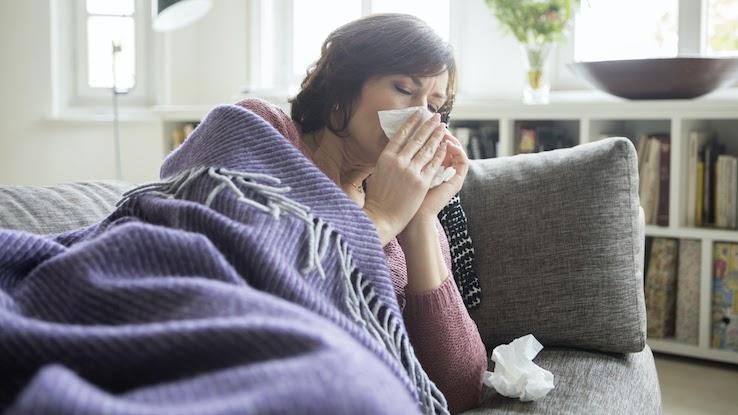
When the weather changes and winter settles in, there are inevitably more sniffling noses and coughs around the workplace, at school and even in the public places you visit frequently. These signs, among others, often make people wonder if they’re witnessing a common cold or a bout with the flu. Both illnesses can be quite similar in their symptoms, treatments and even the ways they’re spread. But they also have some key differences that can help you better assess which illness you’re experiencing if you become unwell.
Common Cold Symptoms vs. Flu Symptoms
The common cold and the flu are both types of upper respiratory tract infections, which means they affect your nose, sinuses and throat. They have very similar symptoms that overlap, so it’s often not possible to tell which one you have based on symptoms alone.

Symptoms of the common cold often include a runny or blocked nose, a sore throat, a cough, headache and a mild fever. Symptoms of the cold are usually self-limiting — meaning they clear up without any treatment — and resolve within a week. If you’re experiencing symptoms and they don’t improve within a week, contact a healthcare professional for advice.
Symptoms of the flu also include those listed above. However, they tend to come on more rapidly and feel stronger. In addition to a sore throat, cough and headache, flu symptoms commonly include profound fatigue, muscle and joint aches, stomach upset, a higher fever and a general feeling that the illness is more severe. A runny or blocked nose may not always appear with the flu.
The duration of each type of illness also varies. It often takes most people more than a week to fully recover from an influenza infection. People with other medical conditions, particularly chronic lung conditions, may become very sick if they contract seasonal influenza and may require hospitalization.
A viral respiratory infection like a cold or the flu can sometimes cause more worrisome symptoms. These include trouble breathing, chest pain, feeling faint, passing out, confusion or a prolonged (more than three days) fever. If you experience any of these symptoms it’s important to seek medical help as soon as possible.
Causes of the Common Cold and the Flu
There are over 200 different viruses that can cause the common cold, with the majority of common colds being caused by rhinoviruses. Other viruses known to cause the common cold include coronaviruses, influenza viruses and parainfluenza viruses. There is no vaccine that prevents people from contracting most common cold viruses.

The flu, or seasonal influenza, is caused by members of the orthomyxovirus family, which are broadly separated into types A and B. Influenza viruses are further categorized by H and N proteins that are present on the surface of the virus. The virus that causes seasonal influenza is known to change, or mutate, each year. That’s why it’s important to get a flu shot every year — new versions of flu vaccines are formulated to protect against the strains that have become more common, and these updated versions provide the best protection.
What Preventative Measures Can You Take?
Both the common cold and seasonal influenza are transmitted in respiratory droplets that are created and expelled when people cough, sneeze, talk, sing or breathe. These droplets contain the virus, and they can also survive on surfaces and hands. You might inhale respiratory droplets from someone who has these illnesses. Or you might touch a surface where the droplets have landed and then touch your eyes, nose or mouth, which transfers the viral droplets into your body. Because colds and the flu are transmitted in a similar manner, the preventative measures you can take to protect yourself are also similar.

One of the most effective ways to reduce the risk of catching a respiratory tract virus is to regularly wash your hands. Cleaning your hands is particularly important after touching a communal surface that other people may have touched, after using the restroom, after blowing your nose or coughing, and before preparing food or touching your face. If you don’t have access to a sink or soap for washing your hands, you can use hand sanitizer that contains at least 60% alcohol. It’s also important to disinfect high-touch surfaces such as door handles, light switches and food-preparation areas.
If you have symptoms of the cold or flu, limit your contact with others. Avoid crowded places and being near people from high-risk groups, such as those with chronic illnesses or senior citizens. Their health may be more negatively impacted if they contract the flu or a cold.
If you do need to go in public, practice social distancing by staying 6 feet away at all times from people who don’t live in your household. You should also apply this distancing rule when you’ll be near anyone who doesn’t live in your home, even if you’re not in a public space with them. When in public or with people who aren’t from your household, wear a two- or three-layer cloth mask that covers your nose and mouth and fits snugly without gaping at the sides. Always direct coughs or sneezes into a clean tissue, which you should dispose of immediately. You should also always wash your hands after coughing or sneezing.
In most cases, our immune systems can effectively deal with common colds and the flu — but this does depend on your health status and whether you have any underlying conditions that can put you at higher risk. In any case, it’s important to maintain a healthy, balanced diet to optimize your immune system’s response to infection.
One of the most effective ways of preventing yourself from contracting seasonal influenza is to receive an updated vaccine each year from your primary care provider. The flu vaccine is designed to help your body create immunity to the flu viruses that are expected to cause infection during a particular year. It takes about two weeks for your body to create immunity to the different flu strains after you get a flu shot. The Centers for Disease Control and Prevention recommends getting your vaccine by the end of October.
Use These Tips to Encourage a Speedy Recovery
Because the symptoms of the flu and the cold generally overlap, it’s not usually necessary to see a healthcare provider unless you feel very unwell, your symptoms worsen or you’re not improving after a week.

There’s no cure for the common cold, so you’ll need to let it run its course. However, you can follow these general tips to aid in a speedy recovery and keep yourself more comfortable:
- Drink more water. When you’re sick, it’s important to stay hydrated. This helps your body to rid itself of the virus while you heal.
- Get more rest. With both the common cold and the flu, you’ll want to allow your body as much time as possible to rest — in particular ensuring you’re getting adequate sleep. Take time off work or school to allow your body to heal and to avoid spreading germs to coworkers or classmates.
- Eat regular and balanced meals. Although you might not have much of an appetite, it’s important to eat small, nutritious meals to aid in your recovery. If you have a painful sore throat — a common symptom — it can be useful to switch to smooth or liquid foods such as soup.
- Take acetaminophen if possible. This pain reliever is widely available over the counter in drug stores, and it can help relieve fever, aches and pains.
- Take ibuprofen if possible. This non-steroidal anti-inflammatory drug (NSAID) is also effective at reducing fever and relieving aches and pains.
- Consider taking decongestants. These medicines can help clear up a blocked nose, mucus buildup in the respiratory tract and coughing. Common options include cough drops, vapor rubs, or over-the-counter pills or capsules.
- Add vitamin C supplements to your routine. These can help boost your immune system’s ability to fight germs.
- Try zinc supplements. These may help reduce inflammation associated with the common cold.
If your symptoms aren’t improving or you start feeling worse, see your primary care provider. They may recommend an antiviral treatment for you, or, depending on how severe your illness is, may want to admit you to the hospital.
Resource Links:
https://www.nih.gov/news-events/nih-research-matters/understanding-common-cold-virus
https://www.cdc.gov/flu/symptoms/coldflu.htm
https://medlineplus.gov/commoncold.html
https://medlineplus.gov/flu.html
https://www.cdc.gov/flu/about/keyfacts.htm
https://www.nhs.uk/conditions/flu/
https://www.who.int/en/news-room/fact-sheets/detail/influenza-(seasonal)
https://bestpractice.bmj.com/topics/en-gb/6





